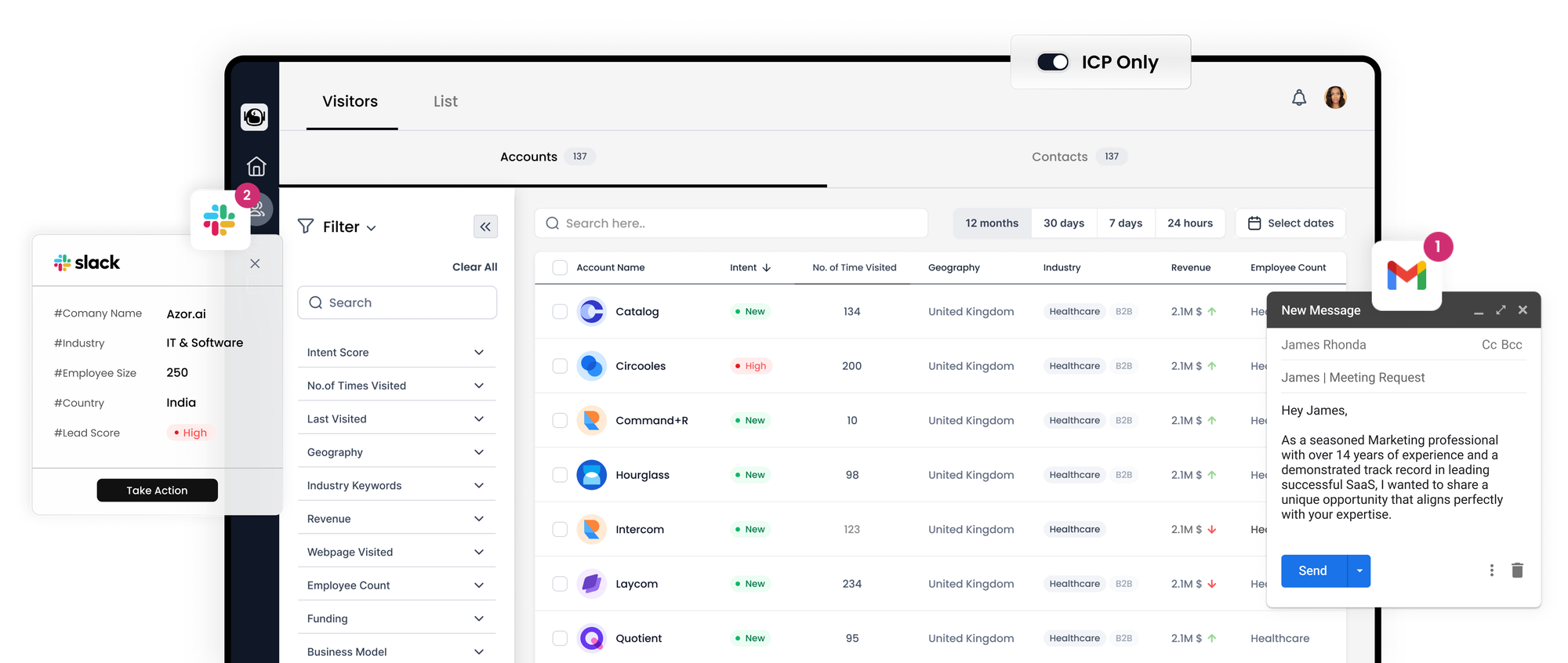B2B Sales Automation: Strategies and Real-World Applications

In the fiercely competitive landscape of B2B sales, leveraging sales automation can be a game-changer, allowing companies to optimize their sales processes and focus on what truly matters—winning leads.
Sales automation involves harnessing technology to streamline sales activities, offering your team the bandwidth to concentrate on nurturing leads and closing deals.
Let's delve into what sales automation entails and examine five actionable strategies to reinforce your sales infrastructure.

Understanding Sales Automation in B2B Contexts
B2B sales are relational and built on sustained effort and personalized interactions over time. Sales automation in B2B isn't about a wholesale replacement of the human element; instead, it's about enhancing the capabilities of sales teams to foster stronger client relationships more efficiently.
Sales automation serves as a force multiplier for your sales force, not a substitute. It's about augmenting the human touch with technological efficiency.
The Advantages of Integrating Automation into B2B Sales
Automation does more than just save time; it transforms your entire sales approach. It relieves your team from the monotony of admin tasks, directing their focus toward cultivating client relationships—the heart of B2B sales.
Beyond mere time management, sales automation streamlines your sales funnel, offering benefits like:
- Streamlined reporting mechanisms
- Accelerated sales personnel onboarding
- Enhanced customer retention and satisfaction
- Refined customer experiences
- Efficient lead generation and nurturing
With approximately a third of sales activities capable of being automated, sales automation opens a world of potential for your team to explore and capitalize on.
The Essence of Effective Sales Automation
To embark on a sales automation journey, begin by mapping out every sales workflow. Consider the lifecycle of a lead from discovery to conversion, and pinpoint the stages where automation could inject efficiency and accuracy.
Examine your sales pipeline critically:
- How are new leads integrated?
- What customer touchpoints exist, and what paths do leads traverse?
- Where are the bottlenecks, and what challenges arise?
- How is data managed and utilized throughout the sales cycle?
Identify areas where automation can mitigate inefficiencies. Often, the best candidates for automation are repetitive, administrative tasks, but even customer-facing engagements can benefit from automated support systems in the background.
Sales Automation Approaches and Tools
Sales automation can be comprehensive, with platforms managing end-to-end sales activities, or it can be modular, addressing specific tasks within the sales process.
Whatever your specific needs, there's an array of automation tools available to streamline various aspects of your sales operations, tailored to fit the nuances of your business.
7 Effective B2B Sales Automation Strategies with Examples
Navigating the complexities of B2B sales requires not just skill but also the strategic use of automation to streamline processes. Here are seven strategies, backed by practical examples, that can transform your sales operations.
1. Streamlining Lead Prospecting with Automation
Automation tools can revolutionize how you discover and integrate new prospects. For example, prospecting software can:
- Seamlessly integrate new leads into your CRM.
- Enrich lead profiles with detailed information.
- Evaluate leads to predict the success of engagement attempts.
- Continuously update your CRM data, ensuring contact details are current.
By automating these tasks, your sales team can shift their focus from data entry to developing meaningful customer relationships.
2. Enhancing Lead Engagement Through Automation
Automating your sales pipeline facilitates a smooth journey for all leads, regardless of their stage. Sales automation software can:
- Trigger personalized communication sequences for leads at different stages.
- Alert your team about lead interactions, signaling prime times for follow-up.
- Adjust your engagement based on the evolving status of a lead.
Moreover, scheduling tools can automate appointment booking, reducing administrative burdens and ensuring timely interactions with prospects.
3. Tailoring Messaging with Automated Personalization
Automation supports a diverse array of content designed to propel leads through the pipeline. For instance:
- Cold email templates can be automatically sent, tailored to specific pipeline stages or responses to concerns.
- AI-powered writing tools can expedite content creation for various communications.
- Real-time guidance tools can offer sales reps instant feedback during customer interactions, enhancing the quality of engagement.
Through automation, you can standardize yet personalize your sales touchpoints, balancing efficiency with a human touch.
4. Boosting Lead Generation with Automated Webinars
Automated webinars allow you to deliver consistent value without the need for live sessions. Benefits include:
- Lead capture: Viewers provide contact information to access content, generating leads for follow-up.
- Enhanced engagement: High-value content positions your company as a trusted information source.
- Insightful analytics: Measure webinar performance to refine future content.
- Efficiency gains: Pre-recorded webinars ensure a flawless delivery with minimal ongoing effort.
Automated webinars can be a magnet for both new and existing customers while demanding little from your sales team post-setup.
5. Streamlining the Quoting Process with Automation
The quoting process is another area ripe for automation. Tools like PandaDoc enable:
- Quick creation and dispatch of quotes.
- Rule-based systems for tailored quotes based on lead data.
- Automated contract initiation and follow-up, reducing delays and ensuring timely action.
From initial interest to final agreement, automation ensures a smooth transition for clients and reps alike.
6. Activating Automated Customer Support Initiatives
Post-purchase, automation can sustain and enhance customer relationships. For example:
- Chatbots and self-service tools provide immediate, around-the-clock support.
- Automated monitoring can prompt proactive support outreach, maximizing customer satisfaction.
Automated systems not only respond to current customer needs but can also identify upselling opportunities, aiding in customer retention and growth.
7. Effortless Customer Onboarding with Automation
Finally, automating the onboarding process ensures customers are effectively integrated into using your product or service. Consider Moosend's approach:
- Automated email series that guide new users step by step.
- Clear CTAs and progress tracking enhance user engagement and education.
By automating onboarding, you provide a consistent, supportive introduction to your offerings, freeing your sales team to focus on relationship-building activities.
Implementing these strategies can lead to a more efficient, more impactful sales operation, allowing your team to excel in building client relationships while automation handles the backend workload.
Advantages of Implementing Sales Automation
Sales automation stands as a game-changer in the realm of B2B transactions, offering a multitude of advantages that streamline the sales process. When properly integrated, it yields numerous benefits including:
Enhanced Productivity: Sales teams can shift their focus from mundane tasks to nurturing customer relations, thanks to automation that handles routine tasks.
Reduced Errors: With automation comes the minimization of human error in data entry and administrative tasks, leading to a smoother sales operation.
Continuous Customer Engagement: Automation ensures consistent communication with potential clients throughout the sales funnel, maintaining their interest and engagement.
Consistent Pipeline Management: Automation provides a structured approach to tracking and managing the customer journey, allowing for more strategic pipeline oversight and improvement.
Heightened Customer Contentment: Prospects receive timely and relevant information, which smooths the path to purchase, potentially increasing customer satisfaction.
Streamlined Onboarding: New sales team members can hit the ground running with established tools and workflows provided by automation, fostering quicker adaptation and productivity.
Ultimately, the overarching goal of sales automation is to bolster sales performance. It equips sales teams with the necessary tools to not only compete but excel in the current market landscape.
Key Insights for Leveraging Sales Automation
In the competitive tapestry of modern commerce, leveraging every available resource to maintain a competitive edge is crucial. Sales automation emerges as a potent tool in this strategy. It unlocks a new dimension of efficiency from webinar hosting to lead nurturing, ensuring a robust sales pipeline and enhanced customer support. For businesses not yet utilizing e-commerce automation, the time to investigate and embrace its potential is now, with the promise of transforming team dynamics and boosting sales outcomes.
